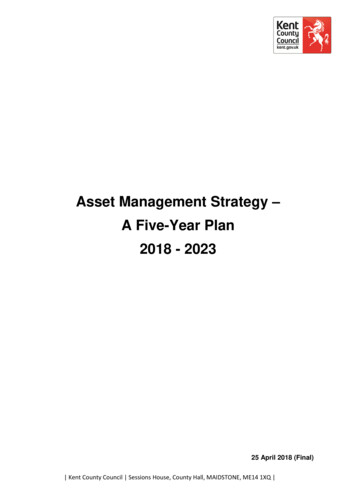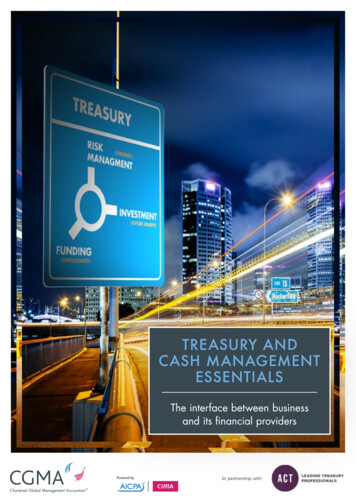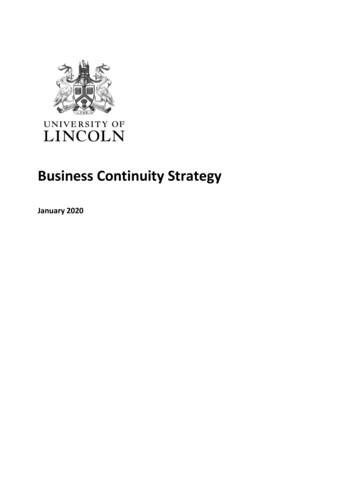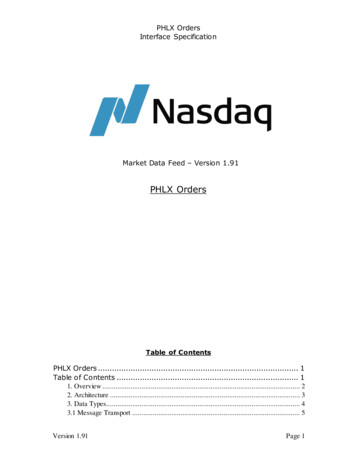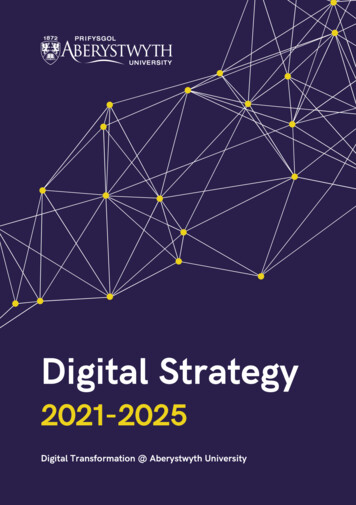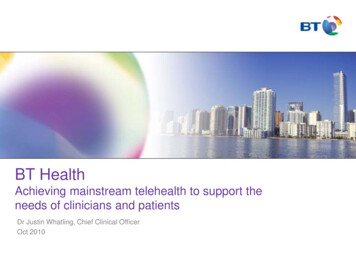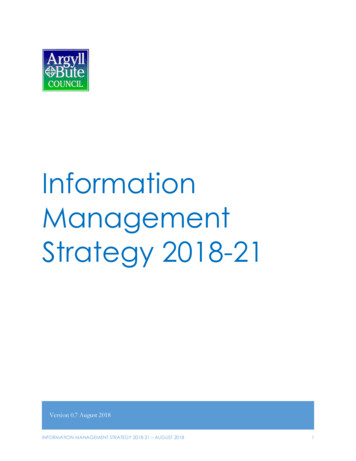
Transcription
InformationManagementStrategy 2018-21Version 0.7 August 2018INFORMATION MANAGEMENT STRATEGY 2018-21 – AUGUST 20181
Table of Contents1Argyll and Bute – Our InformationManagement Strategy .31.1Document Purpose1.2Introduction2Information Management Overview.43Business Context .64Our Vision .75Our Principles .86Council Priorities .1076.1Alignment with the Council’s Corporate Plan6.2Envisaged BenefitsKey Programmes .137.1Governance, Compliance and Assurance7.2Information Asset Culture7.3Enabling Systems and Technologies8Resourcing.159IM Improvement Action Plan .16INFORMATION MANAGEMENT STRATEGY 2018-21 – AUGUST 20182
1Argyll and Bute – Our Information Management Strategy1.1Document PurposeThe purpose of this document is to establish a strategic framework forinformation management across Argyll and Bute Council (the Council).It is aligned with other corporate Council strategies to deliver positiveoutcomes for its staff and customers with an emphasis on complianceand good practice.This document covers the following elements: Information Management Overview Our Vision Our Principles Corporate Priorities Key Programmes Governance Resourcing Action Plan1.2IntroductionThis Information Management Strategy builds on a review of the IM Strategyestablished for 2014 to 2018, recognising that the emerging priorities for the Councilhave been subject to changes over that time.The strategic outcomes are largely unchanged from the original strategy and reflected in“Our Principles”, however, as a Council we face a changing landscape in terms of howwe manage and process information. New data protection legislation, came into forcein May 2018, placing more stringent requirements upon organisations in terms of howpersonal data is handled, and the Public Records (Scotland Act) 2011 requires publicauthorities to agree and adhere to a records management planThis document outlines the approach that the Council will take to the deployment anddevelopment of improved processes, procedure and technologies for bettermanagement of our information. It defines our vision, key principles and overall directionof travel for Information Management across the Council.INFORMATION MANAGEMENT STRATEGY 2018-21 – AUGUST 20183
2Information Management OverviewWhat Is Information?For the purpose of this document Information is defined as any printed or electronicallyheld document or structured data stored in databases within the Council and anyassociated third party organisations.This includes: Any printed or handwritten document including correspondence received by theCouncil; Any electronically held document, including media images, email, officedocuments, social media, audio and video information (often referred to asunstructured information); Any information held in a database or similar repository such as customerrelationship management information, asset management information or financeinformation (often referred to as structured information); and Informal or tacit information held by individuals in notes of meetings, diaries, sitevisit notes, knowledge banks.This deliberately broad and wide ranging definition has the implication that anyinformation, in whatever shape or form, needs to be managed with the appropriate levelof care and attention.Information is essential to all staff, at all levels, and across all services of the Council inorder that they can carry out their day to day duties. The Council needs, within itsregulatory obligations, to safely manage and secure the information created ormanaged, but it also needs to dispose of information that is no longer needed and holdslittle value to the Council. Moving forward we must develop a culture that understandsthere is a balance between the costs of maintaining the information held, versus thevalue of that information to the Council and the services that it delivers.Definition of “Information Management”Information Management describes the means by which an organisation “efficientlygoverns, plans, controls, collects, creates, evaluates, organises, stores, analyses,disseminates, maintains, and disposes of its information, and through which it ensuresthat the value of that information is identified and exploited to the fullest extent.”Information Management is not an ICT issue. It incorporates many elements includingthe nature of the information, the technology used to manage the information, thepeople (both skills and behaviour) used to work with the information - and thegovernance applied to the information including management and leadership.INFORMATION MANAGEMENT STRATEGY 2018-21 – AUGUST 20184
An Information Management Programme has been developed to give guidance to staffwithin the Council that focuses on embedding a culture of better management ofinformation that becomes part of our normal day to day operation. Information isavailable on the hub (Managing Records and Information). This guidance is beingupdated in line with data protection legislation changes from 25th May 2018.Information LifecycleThrough this Information Management Strategy the Council recognises that Informationis an asset to the Council and that the Council needs to manage information through itslifecycle – no different from managing any other asset. Like any other asset, informationhas a value to the Council, its staff, customers, communities, partners and third-partysuppliers. The Council needs to manage the creation, collection and use of informationin a cost effective manner, but more importantly if managed effectively the informationhas the capability to aid effective decision making and support the efficient delivery ofthe services provided.Diagram 1: The Information Management LifecycleEvaluateOrganise andStoreagCaanptMureCreate, Capture& CollecteExisting InformationExisting InformationPlatformsPlatformsSecuritySecurity andandPermissions ModelPermissionsModelIM ProgrammeAnalyseBusiness ProcessProcessBusinessand Policyand PolicyPresent&nio lnt s ate poR e Di sStore, Maintainand DisposalBusiness Use &DisseminateShare &CollaborateINFORMATION MANAGEMENT STRATEGY 2018-21 – AUGUST 20185
3Business ContextTo maximise the potential benefit from our information we need tomanage it effectively, re-use it where we can, share it appropriately andensure that it is adequately protectedThe Council continues to face increasing external scrutiny relating to the various Legal(and sometimes conflicting) obligations that are placed on the Council including the FOI,the enhanced Data Protection legislation in the form of the General Data ProtectionRegulations (GDPR) and PRSA - Public Records (Scotland) Act 2011.GDPR will be in force in the UK on 25 May 2018.It will affect all organisationsprocessing the personal data of individuals in the EU in relation to offering goods orservices and significant penalties can be imposed on organisations and individuals inbreach of the new law, with fines of up to 20 million or 4% of annual worldwideturnover, whichever is greater.Both the GDPR and PRSA legislation requires the Council to evidence the existence ofretention and disposal schedules at an operational level (as opposed to policy levelcommitments to good retention and disposal practice).Throughout the public sector, information sharing and cross agency working is creatingopportunities to streamline services and drive operational efficiencies. Good informationmanagement practices will best place the council to engage in collaborative workingand take advantage of potential efficiencies.INFORMATION MANAGEMENT STRATEGY 2018-21 – AUGUST 20186
4Our VisionThe Council’s information vision is to create an environment where everyone, includingassociated partner organisations values information and supports the manner in whichthe Council governs, manages and uses information.INFORMATION MANAGEMENT STRATEGY 2018-21 – AUGUST 20187
5Our PrinciplesThis Information Management Strategy will be delivered against a set ofprinciples:1. Create a culture which values information and treats it accordinglyAccurate information is essential for all of our employees, every day, and atall levels so that we can all do our jobs individually or collectively as servicesof the Council. It needs to be accurate, available and accessible. We needall to be able to recognise its relevance and value.2. Improve access to information through technology, process andtools,Customers and staff should be able to access information through a numberof channels i.e. Face to face, online, phone or email. Access to informationwill be delivered as “digital first” and customers who can use digital mediawill be enabled and encouraged to self-serve. Those who are unable to selfserve will be assisted to access services so they are not disadvantaged.3. Ensure best use of information by developing opportunities forsharing and re-useThroughout the public sector, information sharing and cross agency workingis creating opportunities to streamline services and drive operationalefficiencies. Good information management practices will best place thecouncil to engage in collaborative working and take advantage of potentialefficiencies.4. Hold information once and securelyThis means we will collect, maintain and secure customer details once. Thisinformation will be used to update all our main systems. So not only will databe secure but it will not have to be provided many times. Risk and securitycontrols should be balanced according to business objectives – securitycontrols should be proportionate to risk. In addition, security should be usertransparent and not cause users undue extra effort.5. Use data wellWe will share the right data within the Council, our partners and withcustomers, in accordance with data protection legislation. We will use dataanalytics to make the right decisions and open up our data where we can toprovide customers, communities and businesses access to what we hold.INFORMATION MANAGEMENT STRATEGY 2018-21 – AUGUST 20188
6. Comply with information management legislation, policies,standards, codes of practice and other guidance.We have in place policies, procedures and guidance for staff to encouragegood working practices and compliance with legislation.7. Develop our workforce to manage information appropriately.We will support our workforce to maintain and develop their skills tounderstand the value of our information, manage and respect it accordingly.INFORMATION MANAGEMENT STRATEGY 2018-21 – AUGUST 20189
6Council PrioritiesThe Information Management Strategy supports council objectives byproviding staff access to comprehensive and reliable information, atthe point of need, where everyone, understands the importance ofhandling it correctly, sharing it appropriately and protecting it fromimproper use.6.1Alignment with the Council’s Corporate PlanThe new Corporate Plan 2018 – 21 states the Councils aim for “Getting It Right” –ensuring “our support services assist front line services to make sure that we get it rightfor our communities and citizens", in particular supporting the delivery of our prioritiesby: Ensuring our structure and systems make our council high performing;Developing our positive organisational culture and remaining an employer ofchoice;Ensuring our workforce have the skills knowledge and behaviours to support ourvision now and in the future;Engaging, consulting and working with our customers, communities and partners’andProviding excellent customer service and communication.Adoption of a corporate IM strategy can help to achieve these aims through: Creating a culture which values information and treats it accordingly;Improving access to information through technology, processes and tools: Improving the efficiency of business processes through the delivery ofworkflow and business process automation; Training staff in the better use of information, with policies and processesin place for sharing information both within and outside of the councilwhere appropriate; Improving the use of information by storing information in a coherent andeasily searchable manner (based on relevance and need), that isaccessible to all staff from any location; and Generating high quality management information that can be used tofacilitate the improvement in business processes. Ensuring best use of information by developing opportunities for sharing and reuse: Controlling the growth in information storage costs by storing informationonce and removing redundant, obsolete and trivial information; and Ensuring compliance with information management legislation, policies,standards, codes of practice and other guidance.INFORMATION MANAGEMENT STRATEGY 2018-21 – AUGUST 201810
6.2Envisaged BenefitsThere are a number of outcomes that benefit the council, staff and customers:Corporate Benefits Identification and understanding of the Council Information Assets will contributegreatly to the creation of clearly defined and understood policy and guidanceRetention and Disposal; Supports broader decision making and policy making; The Council will be better positioned to demonstrate compliance with regulationssuch as Public Records (Scotland) Act 2011 and GDPR 2018; Enables the council to provide a more effective service to its customers withgreater transparency around the information it holds; Increases its efficiency by enabling it to get the most out of the information it holds,avoiding duplication and promoting re-use where appropriate; Reduces levels of information-related risk and helps to ensure that councilinformation is protected and secure; Preserves its public reputation and enables it to meet public expectation of how itwill manage their information; Builds trust in the quality of its information both for staff and the public; Preserves for the public record decisions being made now which will become ourhistory in the future; Increases its efficiency by enabling it to get the most out of the information it holds,avoiding duplication and promoting re-use where appropriate; and Reduces levels of information-related risk and ensures that council information isprotected and secure.Benefits for StaffImproving the way services manage their information brings a number of benefits bothto the individual and the services within which they operate. Good informationmanagement provides staff with the following benefits: Improved searching, retrieving and use of information through the introduction of amore consistent structure for storing information resulting in being able to findinformation quickly and easily; Access to better quality and more reliable information; Better access to the right information as a result of de-duplication of informationand version control;INFORMATION MANAGEMENT STRATEGY 2018-21 – AUGUST 201811
Raised awareness of responsibilities for information handling leading to staff beingbetter equipped to comply with policy and legislation; Use of email archiving, search and classification better understood; Working more efficiently, making best use of existing information resources - reusing information and not reinventing the wheel; Better equipped to work collaboratively - making best use of skills and knowledge; Greater certainty and understanding of what to keep, how it should be kept andwhat to dispose of ; Knowing what to share and with whom; Reassurance that everyone is complying with responsibilities under legalrequirements.Benefits for Customers Information is captured once and not repeatedly; Information is more accurate, reliable and accessible; Assurance that information relating to them is protected and handled appropriately; That when they give consent to share information, that consistent standards will beapplied; The council is more responsive, informed and able to deal with customer queriesand transactions quicker.INFORMATION MANAGEMENT STRATEGY 2018-21 – AUGUST 201812
7Key ProgrammesThere are a number of Key Programmes required to help deliver effective InformationManagement and achieve the outcomes that matter to the Council, its partners andcustomers. The Key Programmes provide the cornerstone for an InformationManagement Improvement Action Plan for 2018 through to 2021: 6.3Governance, Compliance & Assurance;Information Asset Culture; andEnabling Systems & Technologies.Governance, Compliance and AssuranceRole of the Information Management (IM) Steering BoardThe overall aim and role of the IM Steering Board is to set the strategicdirection for Information Management for the Council. The IM SteeringBoard will oversee the implementation of the associated action planthat provides a road map for implementing the InformationManagement Programme and delivery of the Information ManagementStrategy.IM Steering Board Member Responsibilities Provide input and direction for the implementation and ongoing review andgovernance of the Information Management Strategy and Programme;Provide representation from business, HR and technical areas within the Council,supported by specialists on a regular and ‘as needed basis’; andThis Board meets quarterly.Responsibilities of the Strategic Management Team (SMT)The SMT is responsible for understanding the implications, importance and obligationsfor effective Information Management for the organisation as a whole and not on currentorganisational structures and methods, thereby creating an environment where IMinitiatives can be successfully implemented. SMT also has responsibility for supportingkey IM activities with the right level of funds and resources. Information Managementshould always be a consideration of the Strategic Management Team when consideringnew policies and procedure.Responsibilities of MembersMembers have a responsibility to approve the IM strategy for the Council.INFORMATION MANAGEMENT STRATEGY 2018-21 – AUGUST 201813
Audit and Scrutiny CommitteeThe Audit and Scrutiny Committee provide an assurance role for the IM Strategy andimplementation of the associated plan.6.4Information Asset CultureInformation is essential to all staff, at all levels, and across all services of theCouncil in order that they can carry out their day to day duties.The management of our Information Asset Register (IAR) will be embeddedwithin our working practices – by ensuring all staff know what they are, how touse them, and implement retention policies.The Council needs, within its regulatory obligations, to safely manage and secure theinformation it owns, but it also needs to dispose of information that is no longer neededand holds little value to the Council.Encouraging a culture that understands there is a balance between the costs ofmaintaining the information held, versus the value of that information to the Council andthe services that it delivers. Effective Records Management is key with the overallprogramme for better Information Management.The previous Information Management Strategy (2014 – 18) enabled the creation of ourInformation Asset Registers (IARs). Every service across the Council now has an IAR,and these were further developed to assist with preparation for the General DataProtection Regulation (GDPR), and are effectively our “Register of Processing” (anecessity under GDPR).The next step is to embed these IARs within our working practices – by ensuring all staffknow what they are, how to use them, and retention policies are implemented.6.5Enabling Systems and TechnologiesImprove Access to Information through Technology, Process and ToolsMicrosoft SharePoint is a component of the MS Office Professional suite of applicationsand is widely used within the Council with well over 100 sites. An exercise to migrate MSSharePoint 2007 sites to MS SharePoint 2010 has been recently completed. The longerterm plan is to establish a framework for a new MS SharePoint 2016 environment whichwill incorporate predefined templates depending on the nature and purpose of the site.INFORMATION MANAGEMENT STRATEGY 2018-21 – AUGUST 201814
This will allow the pre-population of metadata and rules to help better categorise, organiseand manage unstructured content in a consistent way across the Council.8ResourcingInformation Management is an integral feature of the day to day functions andduties of all staff. Information Management should be appropriately highlightedwithin our Core Competencies.Records Management TeamFuture budgetary pressures are expected over the strategy period given the Council’soverall financial outlook. It will be very challenging to remove further cost withoutreducing the ability of the ICT service to continue to support business improvementactivity across the Council at the current level.The attached action plan is based on current resources. If these change, then arevision of the action plan may also be required. It should also be noted that some ofthe planned actions are dependent on business case justification. If the business casesdo not show a positive return, then these actions will be dropped at that point. Where apositive return is demonstrated, then the savings will be needed to fund the cost of thenew developments.INFORMATION MANAGEMENT STRATEGY 2018-21 – AUGUST 201815
9 IM Improvement Action PlanProgramme 1 – GOVERNANCE, COMPLIANCE & ASSURANCEActionDescriptionPlanned OutcomeOwnerStartEndChange the GovernanceStructure for IM to moreappropriately reflect thecurrent IM structure withinthe Council.Establish a new IM SteeringGroup to oversee the progressof the IM action Plan. New IM Steering Groupestablished New IM Working GroupestablishedIain JacksonJune2018-Corporate Governancefor establishing thecorporate taxonomy/standard metadata.Creation of a CorporateTaxonomy and guidancearound the use offolksonomies/ metadata ( foruse within the new version ofMS SharePoint 2016 SeeProgramme 3 below).Administrators and users ofSharePoint apply the corporatetaxonomy in the organisationand describing of SharePointinformation.Iain Jackson/all Heads ofServiceAug 2018March2019Each Service shall hold acomplete, accurate andconsistent record of allinformation assets.Annual updates/ approvals forall IARS completed.All Heads ofServiceongoingAnnual30thApril2019Carry out an audit/ qualitycheck of the current IARs toassess the classification ofinformation, quality and risklevels assigned.Deviations from SCARRSstandard entries reviewed andapproved.Iain JacksonRelevance OtherProgrammes23(Heads of Service areresponsible for ensuring staffapply the corporate taxonomyin their use of MS SharePoint2016.)Conduct a quality checkof the IARsINFORMATION MANAGEMENT STRATEGY 2018-21 – AUGUST 2018Report on the quality of theIARS following the annual16
review of IARs.Iain JacksonRegular performanceMonitoring for FOI andData Subject AccessRequests.Ensure performance targetsfor these areas are met on aquarterly basis.Compliance with both FOI andGDPR legislativerequirements.Iain JacksonongoingQuarterly from 1April2018Assurance for theimplementation ofretention and disposal ofrecords in accordancewith the Council’sRecords ManagementPlan.All actions completed as setout in the RecordsManagement Plan (RMP).Assurance that informationmanagement processes arebeing applied in accordancewith RMP.Iain JacksonongoingAnnual30thApril2019Programme 2 – INFORMATION ASSET CULTURERelevance OtherProgrammesActionDescriptionPlanned OutcomeOwnerStartEndEmbed the use of IARsacross the organisationEquip staff with theknowledge of what to usethe IARs for and putprocesses in place to assistwith the implementation ofretention policies. All services must ensure thatstaff know what the IARs are forand how to use them All services must ensure thatretention and disposal is carriedout in accordance with the IARHeads ofService/ Iain JacksonongoingAnnual30th April2019Implement anAwareness TrainingProgramme for IMacross the organisationIntroduce an appropriateprogramme and a set oftraining materials to ensureall staff are aware of theirresponsibilities around themanagement of information.Staff understand what is required ofthem in terms of improved IMJane Fowler/Iain JacksonApril 2018July 2018INFORMATION MANAGEMENT STRATEGY 2018-21 – AUGUST 201813Mandatory Records managementtraining module for LEON almostready17
Review Core Competenciesfor staff with specificreference to Information andRecords ManagemntProgramme 3 – ENABLING TECHNOLOGIESRelevance OtherProgrammesActionComplete a MSSharePoint 2016corporate environment.Description Creation of a MSSharePoint (MSSP) 2016corporate framework to becreated which reflects theCouncils agreedTaxonomy and metadata. Revisit the benefits ofacquiring additionalrecords managementtechnologies, based on animproved, betterorganized MSSPcorporate environment.Migration of all 2010MS SharePoint toSharePoint 2016.Assess existingsystems for hostingunstructured data todetermine whethercompliance with GDPR The mapping andtransformation of existingMS SharePoint 2010 sitesto new MS SharePoint2016 frameworkenvironment.Review capacity of networkdrives to provide an audittrail, business classificationfiling structure, retention anddisposal of documents.INFORMATION MANAGEMENT STRATEGY 2018-21 – AUGUST 2018Planned OutcomeOwnerStartEndA MS SP environment that enablesa greater level of consistency in theway that non structured data isstored and described. Improvedrecords management capability;KatrinaDuncanJune 2018June2019Sep 2018Jan 2019January2019June2020Nov 2018April 2019Revised business case forsupporting Records ManagementTechnologies.A greater level of consistency in theway that non structured data isstored and described. Improvedrecords management capability.KatrinaDuncanProvide a recommendation to IMbased on complianceeffectiveness.GovernanceTeam alongwith NetworkDriver Owners/Service Leads1218
Programme 3 – ENABLING TECHNOLOGIESRelevance OtherProgrammesActionDescriptionPlanned OutcomeOwnerStartEndReview of GDPR highpriority businesssystems to ensurecompliance with IMStrategy.Review products anddevelop roadmaps of 3rdparty software to ensure weare best supported throughexisting contracts andsoftware for IM best practiceand compliance.Identify opportunities andimplement 3rd party softwareimprovements that support theCouncil in achieving betterinformation management inaccordance with our recordsmanagement principles ensuringcompliance with legislation.ICT CLOs andService LeadsAugust2018February2019Optimise the use of theCivica corporateDocument ManagementSystem Disposalsfunctionality forimproving InformationManagement andRecords ManagementDetermine and implementan improvements actionplan of improvements foroptimizing the use andeffectiveness of this existingresource.Richer disposals functionalityimplemented to ensure bothrecords and documents can beidentified and removed inaccordance with retention policies.IM SteeringBoardJune 2018June2019Develop an improvedmethod of hosting theIARsReplacement of flat, nonfunctional, spreadsheets forhosting IARS (Record ofprocessing) with a smalldatabase application. Thiswill allow all staff basicaccess and assist withimplementation of retentionpolicies.A more user-friendly method ofaccessing the IARs anddetermining what should happen toa record. Improved visibility ofcompliance and associated actions.KatrinaDuncanMay 2018Nov 201812and PRSA can beachievedINFORMATION MANAGEMENT STRATEGY 2018-21 – AUGUST 201819
INFORMATION MANAGEMENT STRATEGY 2018-21 - AUGUST 2018 3 1 Argyll and Bute - Our Information Management Strategy 1.1 Document Purpose The purpose of this document is to establish a strategic framework for information management across Argyll and Bute Council (the Council). It is aligned with other corporate Council strategies to deliver positive
